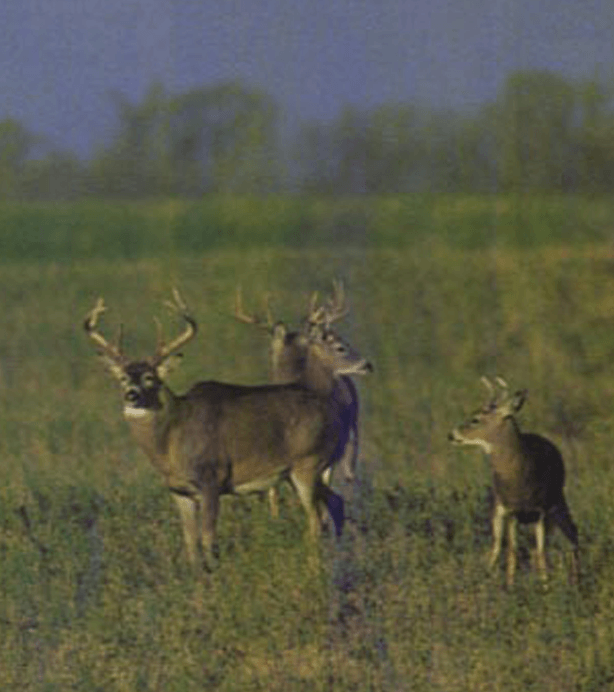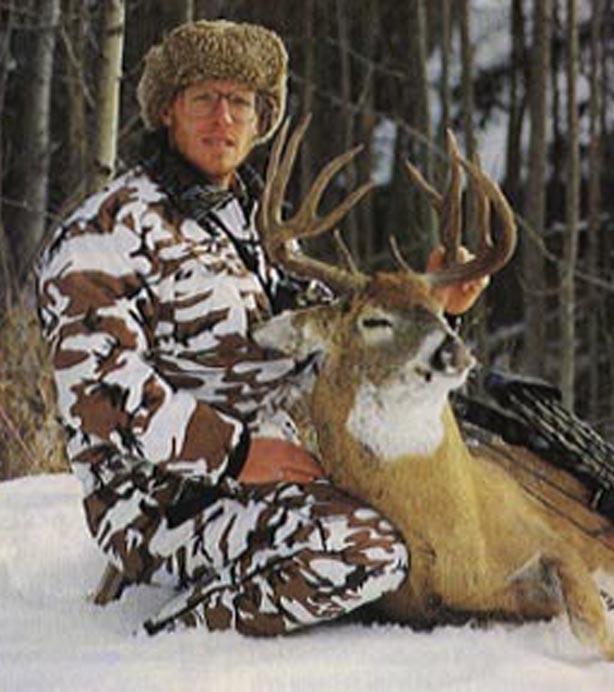Cold & Quiet
by Brian Rusk
(Bowhunter Magazine, Nov, 2010)


This northern proving ground teaches lessons that will aid whitetail hunters anywhere.
The Edmonton Bow Zone may be one of the best places in North America to bag a huge whitetail. It’s also one of the toughest places to hunt because the deer there, under a constant onslaught from hunters, wolves, and coyotes, reach maturity only if they’re super wary. Perhaps what makes the Zone toughest is the weather. As most everywhere else, prime hunting takes place during the rut in November, and in northern Alberta, that means snow and air temperatures down to zero F. and below.
While many hunters never fool a big Zone buck, others do it every year. Rick Huempfner first hunted the Bow Zone in 1991 with a recurve bow and cedar shafts. That first year he shot a 160-inch 10-pointer, and he was hooked. Since then, Rick and his brothers, John and Brad, and their good friend Tony Zambon, have hunted the Bow Zone with Jim Hole, Jr.’s Classic Outfitters every November for the past 12 years. Among the four of them, they have defied the odds by killing big bucks every year. How have they maintained high success under low-odds conditions? That answer starts at the beginning of their bowhunting lives.
Rick, John, and Brad grew up hunting in northeast Wisconsin, where their father, Don, and uncles Bill and Dave, taught them to hunt.
“Even though we rifle hunted then, our dad taught me and my brothers to sit still and be quiet,” Rick said. He also taught them how to dress to stay warm during the typically cold weather of Wisconsin’s rifle season. Thus, the first time Rick hunted the Bow Zone, he felt right at home, as the timber, cold temperatures, and dead silence brought him back to those childhood hunts with his dad.
The Huempfners and Zambon make no claims to being great hunters. Rather, they say the little things are what make them successful in the frigid silence of the big woods. “Quiet is the key,” they agree.

Jim Hole, Jr. believes that success comes with organization. “It’s a sport of details,” he said. Buying into that philosophy, the Huempfner brothers and Zambon go through every equipment item and technique to ensure absolute organization. They practice with their bows while wearing their cold-weather clothing. They shoot bows with shorter-than-normal draw lengths to avoid clothing interference with the bowstring. They practice hanging their stands safely without making a sound. Above all, they avoid making unnatural, clanking sounds, which can carry long distances in the still, brittle air of the winter woods.
To ensure absolute silence on stand, they are always listening to their gear, and they wrap black hockey tape around anything that could possibly make noise, including all the tubing of their treestands. In particular, they put their hunting packs to the test. If the material in a pack gets stiff in the cold, these hunters will not use it. They must be able to reach into their packs without making a whisper of noise, so they prefer small, unlined wool or fleece packs.
These hunters give clothing similar scrutiny, and the reason is simple: They must dress warmly enough to remain motionless on stand yet move silently when the time comes for a shot. None of them dresses exactly the same, but they all adhere to the same layering principles. All start out with a moisture-wicking base layer. Rick likes to wear two pairs of long underwear — one light, and then a heavier pair. Over the wicking layer they put on a lightweight wool shirt or sweater, followed by another lightweight fleece layer.
Over these inner layers they don a scent-eliminating layer of carbon-based clothing, and then they add Berber fleece bibs containing a wind-blocking material. When the wind blows and the temperatures drop into the negative digits, they’re glad for the wind-blocking properties of their bibs. Plus, the bibs zip up high onto the chest to hold in core body heat.
All of these hunters wear wool outer jackets. No matter how cold the temperature, they carry their jackets in their packs to the stand to keep from overheating and sweating.

Brad bagged this 190+ brute during the 2008 season.
They consider the wool outer layer the key to silent movement when the whitetails are close. They figure other materials are equally warm, but perhaps not as quiet as wool in cold weather.
Keeping their feet warm is simple: They start with lightweight socks, followed by heavier wool socks pulled up to the knees. On extremely cold days, John likes knee-high wader socks. They all prefer white Mickey Mouse military boots to maintain warm feet on bitter days.
To keep his hands comfortable, Rick wears lightweight gloves and keeps his hands in his pockets most of the time he is on stand. A couple of chemical handwarmers in the large front pockets of his wool jacket keep his hands warm without making them sweaty. All of these hunters carry an extra pair of gloves in their packs in case their gloves get snowy and wet as they climb into their stands. Dry hands are warm hands.
Coming from a state like Wisconsin that produces so many record-book bucks, why do these four hunters annually travel hundreds of miles to Alberta to hunt whitetails?
“No place on earth is as special as the Bow Zone,” they all agree.
“It is just a place that works for me,” Rick said. “While sitting in the Bow Zone, time just seems to fly by because you know at any moment a monster whitetail buck could step out. When one of those bucks walks into your life, you forget about everything else. The cold is gone, work is just a distant memory, and your body and soul are free. At that moment the world makes sense.”
Over the years the foursome has shot some impressive deer, but more impressive to the group is the number of truly world-class bucks they have seen. Tony shoots a longbow and has had to watch several bucks larger than anything he has ever harvested walk just out of his range. That is saying something considering he shot a 193-inch nontypical while hunting with Classic Outfitters in 2003.
Rick has also had his fair share of close calls. He said he has had at least six Boone and Crockett-class bucks within 45 yards over the years. He has had many successful seasons there but sometimes holds out only to watch a deer of his dreams, just inches from a clear shot, turn and slowly fade away into the Canadian forest.
John Huempfner did not make the trip to the Bow Zone in 2008 — the first time in 17 years — because he drew an Iowa bow tag. He may have had second thoughts about that decision after he got word that his brother Brad had killed a 190-plus-inch Alberta giant on the third day of their hunt, and that Tony had shot another beautiful buck with his longbow.
Hunting under some of the toughest conditions in North America, Rick, John, and Brad Huempfner, and Tony Zambon, have proven time and again the value of organization, attention to detail, and proper clothing under bitter conditions. They’ve learned to hunt warm and silent in the cold and quiet, and the results speak for themselves.
The author is a forester who lives with his family in Lake Nebagamon, Wisconsin.



